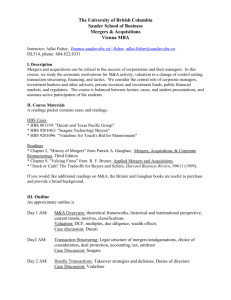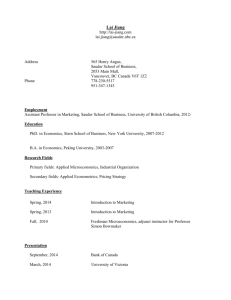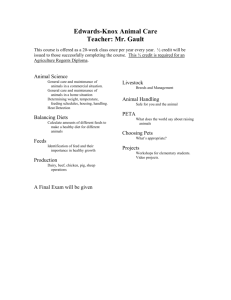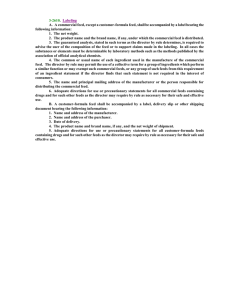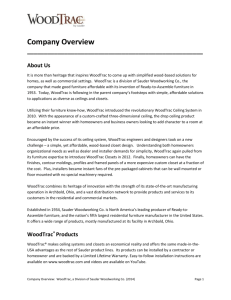Intro:
advertisement
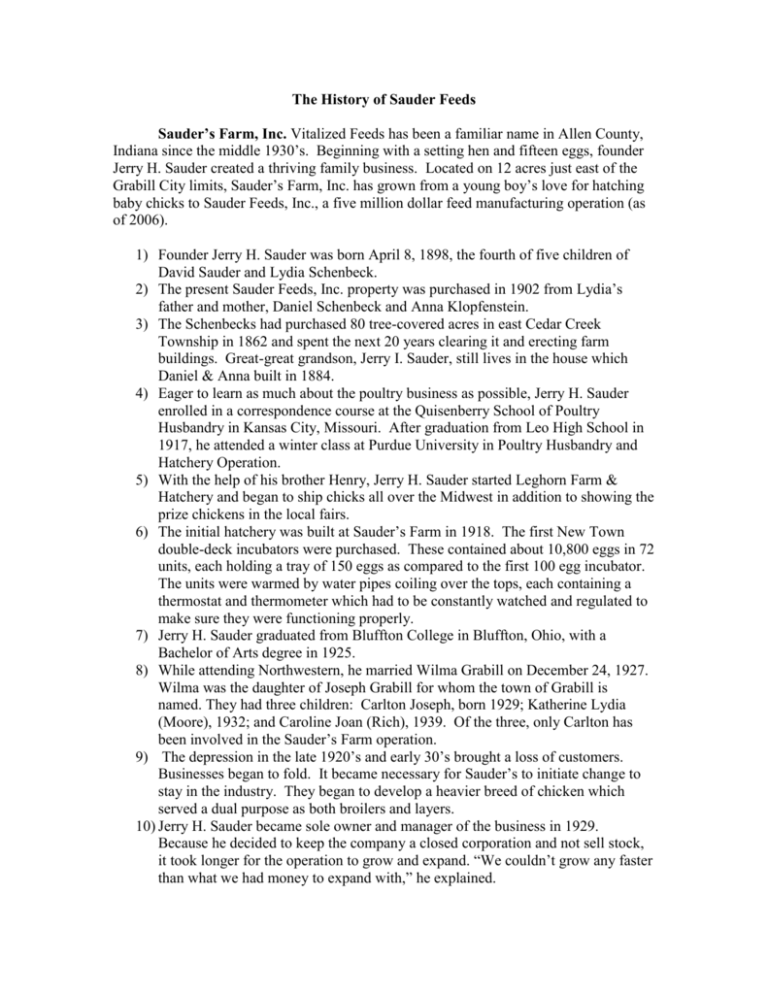
The History of Sauder Feeds Sauder’s Farm, Inc. Vitalized Feeds has been a familiar name in Allen County, Indiana since the middle 1930’s. Beginning with a setting hen and fifteen eggs, founder Jerry H. Sauder created a thriving family business. Located on 12 acres just east of the Grabill City limits, Sauder’s Farm, Inc. has grown from a young boy’s love for hatching baby chicks to Sauder Feeds, Inc., a five million dollar feed manufacturing operation (as of 2006). 1) Founder Jerry H. Sauder was born April 8, 1898, the fourth of five children of David Sauder and Lydia Schenbeck. 2) The present Sauder Feeds, Inc. property was purchased in 1902 from Lydia’s father and mother, Daniel Schenbeck and Anna Klopfenstein. 3) The Schenbecks had purchased 80 tree-covered acres in east Cedar Creek Township in 1862 and spent the next 20 years clearing it and erecting farm buildings. Great-great grandson, Jerry I. Sauder, still lives in the house which Daniel & Anna built in 1884. 4) Eager to learn as much about the poultry business as possible, Jerry H. Sauder enrolled in a correspondence course at the Quisenberry School of Poultry Husbandry in Kansas City, Missouri. After graduation from Leo High School in 1917, he attended a winter class at Purdue University in Poultry Husbandry and Hatchery Operation. 5) With the help of his brother Henry, Jerry H. Sauder started Leghorn Farm & Hatchery and began to ship chicks all over the Midwest in addition to showing the prize chickens in the local fairs. 6) The initial hatchery was built at Sauder’s Farm in 1918. The first New Town double-deck incubators were purchased. These contained about 10,800 eggs in 72 units, each holding a tray of 150 eggs as compared to the first 100 egg incubator. The units were warmed by water pipes coiling over the tops, each containing a thermostat and thermometer which had to be constantly watched and regulated to make sure they were functioning properly. 7) Jerry H. Sauder graduated from Bluffton College in Bluffton, Ohio, with a Bachelor of Arts degree in 1925. 8) While attending Northwestern, he married Wilma Grabill on December 24, 1927. Wilma was the daughter of Joseph Grabill for whom the town of Grabill is named. They had three children: Carlton Joseph, born 1929; Katherine Lydia (Moore), 1932; and Caroline Joan (Rich), 1939. Of the three, only Carlton has been involved in the Sauder’s Farm operation. 9) The depression in the late 1920’s and early 30’s brought a loss of customers. Businesses began to fold. It became necessary for Sauder’s to initiate change to stay in the industry. They began to develop a heavier breed of chicken which served a dual purpose as both broilers and layers. 10) Jerry H. Sauder became sole owner and manager of the business in 1929. Because he decided to keep the company a closed corporation and not sell stock, it took longer for the operation to grow and expand. “We couldn’t grow any faster than what we had money to expand with,” he explained. 11) Sauder’s began to produce chicken, swine, and cattle feeds in 1935 after installing a feed mixer and grinder which would give them full control of the feeding programs. 12) By 1940, small hatcheries were gradually fading out because the egg business went to larger operations, some of which could hatch 100,000 leghorns in a week. Farmers didn’t have a market for their eggs any longer, and many went out of business. The broiler chick business was going the same way. The big operators were taking most of the business away from the small tradesmen. Jerry’s farsightedness, however, in experimenting with and developing diversified feeds provided Sauder’s Farm with a turning point. Not only did the company survive, but it prospered into the highly successful enterprise it is today. 13) 1938 - A mill was constructed, and Sauder’s Farm soon became one of the leading suppliers of feeds and custom grinding services for local farmers and livestock producers. Due to the demands of increasing business, during the next 30 years, the mill was enlarged five times 14) 1951 to 1955 - Carlton, Jerry H. Sauder’s son, graduated from Bluffton (Ohio) College in 1951 with a Bachelor of Science degree. The following year, Carlton was a student at Purdue University, enrolled in the poultry and animal husbandry department. After serving two years in Korea with the U.S. Army Signal Corp, Carlton officially joined his father in the operation. 15) November 26, 1965. Tragedy struck the Sauder family. Around 1:00 in the morning, Carlton was awakened by someone pounding on the door. A man driving by had seen flames at the elevator and hurried to the house. Carlton phoned the Grabill Fire Department. Soon the Cedar Canyons and St. Joseph’s fire departments responded also. Carlton rushed to the feed mill and saved their truck fleet from being incinerated. But the original feed mill and grain elevator which had been built in 1938 were totally destroyed. 16) After an interruption of sixteen months, on July 29, 1967, Sauder’s Farm, Inc., held an open house to celebrate resuming full production of Sauder’s brand complete and supplemental poultry and livestock feeds. Once again, they were in business. 17) A second fire, nine years later in 1974, destroyed the barn which contained the feed mill supplies. Corn cobs which were stored in the barn were ignited by hot steel particles blown into the cob pile from the hammer mill. 18) A third fire, in 1975, burned down the hatchery building. Gasoline spilt from a motor that was being repaired in the basement, ignited and flames followed the walls up to the second floor. Wood excelsior pads, used in the bottom of chick boxes, were ignited and burned out of control before the hatchery could be saved. 19) Also, in 1975 Jerry I. Sauder, Carlton’s son, joined the firm along with his wife, Kathy. Jerry and Kathy have continued to be an active part of the growth of Sauder Feeds, Inc. up to the present time. 20) In the late 1970’s Jerry I. Sauder invested in the construction of a grain handling facility to offer the local farmers a market for their corn. This provided a perfect fit for the corporation as they could then use this corn in their feed production plant. 21) In the mid 1980’s additional grain storage was erected and a more efficient and updated grain dryer was purchased. Sauder’s continued to diversify and change to service their customers’ needs. As many of the smaller mills shut their doors during this time due to the competition with larger conglomerate mills, Sauder’s continued to look for opportunities to utilize their vast array of ingredient inventory and pelleting equipment to increase their business. 22) In the early 1990’s the Sauder family said good-bye to the founder of Sauder Feeds, Inc., Jerry H. Sauder, and his wife. They not only left behind a well established business built with love and hard work, but also a heritage that exemplified a life of Christian love, service and concern for all people. 23) In 1993 a corporate decision was made to change the name of the business from Sauder’s Farm, Inc. to Sauder Feeds, Inc. This name change was to more effectively describe the nature of the business. 24) In 1996 Sauder Feeds, Inc. upgraded their computer technology to a fully networked environment that offered more information to the company as well as to their customers. 25) In the late 1990’s the grain operation continued to grow and expand, requiring Sauder Feeds, Inc. to store corn off site. This in turn encouraged Jerry I. Sauder to purchase a used flat grain storage building and reconstruct it at the Sauder Feeds, Inc. plant providing an additional storage of 130,000 bushel of corn. Total storage capacity was now 290,000 bushel. 26) Also in the late 1990’s Sauder Feeds, Inc. began a joint venture raising layers in Northwest Ohio and selling the eggs on the market. In 2001Sauders completely took this venture over and became Sauder Eggs. This was a good fit for the company that had deep roots in the poultry industry. The feed for these layers, of course, was purchased from Sauder Feeds, Inc. 27) In 1999 Jerry I. Sauder started another company, Sauder Trucking Co. This company not only was and is used to truck feed for Sauder Feeds, Inc., but also trucks commodities for other agricultural vendors. This new venture has served Sauders well in their effort to diversify the operation. 28) In 2002 the 4th generation of Sauders joined the firm. Josh Sauder, son of Jerry I. Sauder, graduated from Bluffton College and added his talents to the employee mix. Jerry & Kathy Sauder have 3 children, Josh, Maria, and Megan. Maria (Klea) has often helped the firm with her graphic design talents. Megan also spends her college breaks working at the firm, using her organizational and computer skills to complete many time consuming projects. Jerry and Kathy continue to add their efforts and management to the ever changing face of their family business, Sauder Feeds, Inc.

